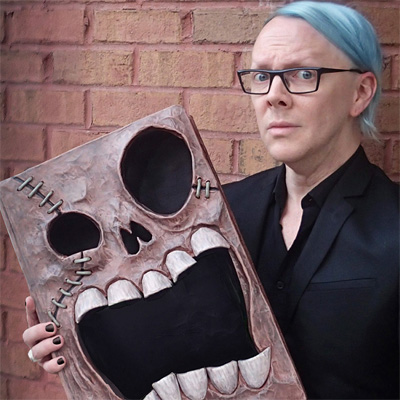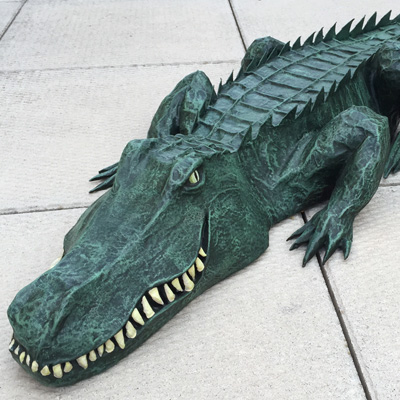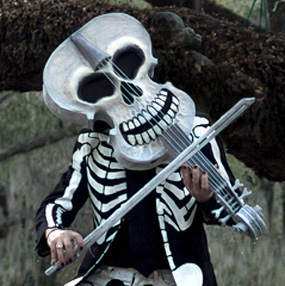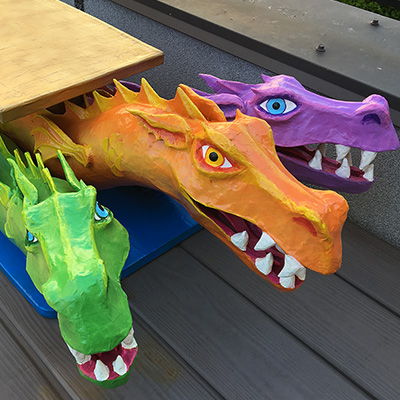Advanced paper maché mask-making tips, part 2
Published by Manning on October 2nd, 2016
Okay, I wrote up some more of these tips! (Part one of my tips for making big paper maché masks is here.)
Design a base that’s easy to break apart
Maybe my favorite part of the whole mask-making process is the step when all the paper maché is dry and it’s time to cut the mask open and remove all the foam board, styrofoam, poster board, etc, along with tons and tons and tons of masking tape. While fun, this can be challenging and a little annoying at times because lots of the large shapes are locked into the paper maché and you have to do a lot of work cutting them apart from the inside before removing them in pieces. I use an X-acto knife and dig around in the mask, slicing things apart (and sometimes slicing myself up a bit!), but it’s tough to see what I’m doing with my hands in the way and it’s tough to get at some of the pieces if they’re sort of around a corner or whatever.
So, I trick I’ve been doing on recent projects is designing my large solid base shape, and then cutting it apart before doing all those layers of paper maché. I cut the base apart wherever possible and then put it back together with a little bit of masking tape. That way when it’s time to cut open the paper maché, you can just snip those little masking tape connections, and the big pieces are easy to pull out.
A friend of mine came up with a great use for this method. The largest object in his base was a huge styrofoam ball. If he simply built his mask around that and covered it in paper maché and then cut it open and tried to remove the ball, he’d be faced with a ridiculous amount of work; he’d have to hack at the styrofoam ball and dig it out in tiny pieces, no doubt making a huge mess. Instead, he thought to slice the ball into eight pieces first, like orange wedges, and then put them back together with a little tape. Then when he opened up his paper maché he could snip apart and pull out those big wedge-shaped pieces much more easily.
Make curved foam board shapes with masking tape
I’ve mentioned these tricks in a few of my articles about individual projects. I use masking tape in two different wants to make bendable shapes.
The first technique is to make a single piece of foam board bendable. Start by cutting out your foam board shape. If your foam board is cheap enough that you can easily peel the paper layers off of both sides, then do that; otherwise don’t worry about it. Now cover both sides with masking tape, as thoroughly as possible so you’re covering all (or almost all) of both sides. Now, you can carefully roll up the foam board from one end; roll it all the way up, and then unroll it and start from the other end and roll it up again. Unroll it and you’ve got a nice pliable bendable piece of foam board, ready to tape onto your project.
The second technique is to make two pieces of foam board curved and make them keep that curve. I used this for the foam board antlers I made a while back. Start with my technique above; cut out two pieces of foam board and cover them with masking tape but don’t roll them up. Then, hold the two pieces together and wrap tape around them at the base so they’re locked together at one end. Now, curve the two pieces together, hold that curve with your hand, and put some tape around the end. Let go and the pieces retain the curve perfectly!
The first method works if you’re taping the piece down onto another surface; you can hold the curve you want that way. The second method is good if you’re not going to tape the piece down onto something, i.e. you need the curved shape to stand out on its own, like my antlers.
My 3-step base-making process
My method for making the base structure for most of my paper maché masks is this: 1) build a precise and sturdy geometric shape with hard angles, 2) smooth it out with a layer of something soft, and 3) wrap the whole thing in masking tape. (Then do the paper maché.)
I do a ton of sketching before starting on a project, and I even do a lot of designing in Photoshop in order to get measurements right and stuff. I usually end up executing my basic design with various cut-out pieces of foam board and other objects, taped together at different angles to achieve the overall complex shape that I want for my mask. It’s nearly impossible to create a shape with foam board that consists of rounded shapes or smooth edges, so my base structure usually ends up with some hard angles and ugly lines. I smooth out these shapes by adding an exterior layer using any of a number of different softer, more flexible materials — this might be tons of strips of craft foam taped in place all over the base, or a long strips of bubble wrap tightly wound around the base and taped in place, etc. Even just a ton of layers of tape will help with this, but we’re talking like five or six complete layers of tape, which can get expensive and still won’t smooth out the big hard angles very much. Anyway, once I finally get the corners rounded out as best I can, I always cover my entire base with one last layer of masking tape. This isn’t for the shape, it’s to provide a release agent so the paper maché won’t stick to the base very well. When I finish all my paper maché and open up the mask to remove the base materials, the masking tape can be removed from the paper maché without damaging it (if you’re careful!) and you’re left with just a strong, super lightweight paper shape.
Make a reusable base for identical copies of your mask
I usually make a base that I plan on destroying when I remove it from the mask, but with a little more planning and effort you can make a reusable base that will allow you to make identical copies of your paper maché mask.
You can pretty much make your base the usual way, which for me means building a shape and then covering the whole thing with masking tape. Next, cover the base with aluminum foil or plastic cling wrap. Both can be frustrating to work with for different reasons but with a little patience you’ll be able to create a fairly form-fitting covering, using a few pieces of tape here and there as needed to connect everything. Then, when it’s time to do your layers of paper maché, be prepared for the drying time to be very long. The plastic and/or foil will make the paper maché dry much slower than usual, since no air can get in underneath the paper maché. When all your layers are done and 100% dry, you can slice the paper maché shape open with an X-acto knife, cutting the whole paper maché exterior in half; I usually do this on the sides. Then you can carefully pull the two big halves apart, and the plastic or foil will come off with them; you can then pull this stuff out of the paper maché and discard it. Then you can connect your paper maché halves with masking tape and a layer of paper maché to cover the tape.
Then you can re-use the base! Just cover it with foil or plastic wrap again and you’re ready to do the second round of paper maché. I used this method for my twin skull masks project (article coming soon!).
Make a stand with wine bottles
Empty wine bottles are a cheap and easy way to make a very sturdy temporary stand for your masks, perfect for when you’re letting a coat of paint or a layer of paper maché dry. Depending on the size and shape of the mask I’ve made these a few different ways. The easiest way is three wine bottles taped firmly together at the base. This makes a surprisingly strong and stable shape that’s very difficult to knock over. If the mask is too tall for just the wine bottles, I’ll add a roll of poster board standing in between them, and put something over the top of it like a plastic cup in order to protect the interior of the mask; if the paper maché is too flimsy or not 100% dry the rolled up poster board might jab into a bit too much. A cup helps disperse the weight and protect your structure.
If you need an even stronger stand for a much larger or heavier project, you can use six wine bottles and arrange them in a flower pattern, with five circled around one, and tape them all together. You can then add a strong tube made out of several layers of rolled poster board on top, similar to the first method above. To disperse all that weight at the top, you can add an upside-down plastic bowl or some other large wide shape like that.
The above methods are super quick and easy and will still allow the mask to wobble around quite a bit, so it’s not an ideal situation for actually working on your mask — like if you were doing any fine painting of details, or gluing parts on, or sculpting clay onto the mask — these stands are way too wobbly for that kind of work. If you want a truly stable, solid stand for that kind of work, you can make something that’s only a little more complicated. I take a long piece of cardboard roll it up into a huge, wide tube that fits snugly into the opening of the mask. Tape the tube closed, stand it up, and then insert four or five wine bottles into the base and tape them in place inside with packing tape. That will give you a nice solid base that’s very bottom-heavy and can’t tip over, and it should be strong enough that you can actually apply pressure on the mask as you work on it.
These are extremely low-tech methods but they’ve really come in handy for me! Particulary when I have to spray paint a mask outside and leave it out there for a few days to air out; a nice heavy stand like this will keep your project from tipping over in the breeze and ruining your work. Plus this means part of your prep work for painting is emptying all those bottles!
Tips for making teeth
Making teeth for a mask can be torture, so I wrote a whole article about my teeth-making methods.
More soon!
Further reading
- My paper maché method for masks, Halloween projects, etc
- My painting method for paper maché masks and other projects
- Making big paper maché masks — advanced tips
- Teeth-making tips for big paper maché masks
- Craft materials — choosing the right brands
- Tips for working with foam board for art projects

 About Manning Krull
About Manning Krull How to make a 4-foot paper maché alligator
How to make a 4-foot paper maché alligator My violin skull mask, Mardi Gras 2015
My violin skull mask, Mardi Gras 2015 Three-headed paper maché dragon sculpture
Three-headed paper maché dragon sculpture
February 9th, 2022 at 5:19 am
I really love your work! It’s wonderful! Was looking for some info on mask making and you are so generous!
I need to make a round and really flat type of mask for my son, even flatter than Barrel’s Mask from Nightmare Before Christmas. Was thinking of making a papier mache over a blank cardboard mask, so he’ll have space for his face, flatenning the outside surface with layers of air dry clay or something similar and lightweight. Do you have any better sugestion on how should I make it so it could be wearable and comfortable? Thank you!
February 9th, 2022 at 12:09 pm
Hi Alex! Thank you! I’m not sure if what I’m picturing is correct: kind of like a thick coin shape, or a checker — flat on the front and back and with enough depth that your kid’s face can fit into the back of it. To do something like that I’d probably start with two flat foam board (or cardboard) circles, and build an edge around them (maybe 3″ wide?) with poster board or cardboard, all taped together with lots of masking tape. Then I’d buy a store-bought plastic face mask that’s comfortable, like with elastic straps and maybe some padding inside. Cut a hole in the back surface of the coin shape to fit the face mask inside, and then then tape and/or hot glue all around the edges of the face mask to secure it. I’d then cover the whole coin shape with one layer of paper mache, just to hide the tape and give the whole thing a uniform surface. (And of course if you want any 3D facial features on the front of the coin shape you’d add them before paper mache.) Feel free to email me at manning at manningkrull dot com if you want to discuss!
February 9th, 2022 at 3:21 pm
That’s a great idea! Didn’t think about making it thick and two layered, that’s probably because I wasn’t thinking of making it nice looking on the back side too :)
Thanks again!